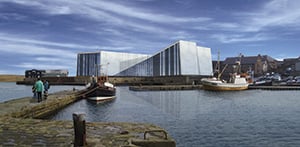Selling a stake
In the first of our brand new series on strategies for financial sustainability, Gwilym Gibbons explains how his organisation is exploiting its intellectual property

Shetland Arts is a social enterprise with a very simple social purpose: to make, support, promote and encourage great art and creative experience – from festivals, concerts and exhibitions, to drama workshops, writing residences, cinema and outdoor theatre. Shetland’s recent listing as one of Lonely Planet’s top ten ‘must visit’ places, demonstrates the value of our location. The natural and cultural heritage of the isles inspires diverse creative activity in both its residents and visitors. As such, Shetland Arts works across a range of artforms: drama, music, literature, contemporary craft, visual art, film and dance.
NORTHERN LIGHTS
Shetland Arts runs a theatre and a gallery, and is in the process of building the UK’s most northerly creative hub, Mareel, a £12.2m music, cinema and creative industries centre due to open next spring on Lerwick’s picturesque waterfront (AP184). Mareel’s initial development funding was secured through a range of local, national and international sources, but the venture has no revenue funding to support its operation and activity. The politer people I meet say I am “brave” to open a new cultural centre in a location like Shetland with no ongoing revenue funding. But I think about all the arts professionals out there running large creative centres based on business models better suited to a time of public subsidy; they have a far greater challenge in my eyes. When I embarked on this venture I knew that revenue funding would not form part of the Mareel balance sheet. I also knew that our greatest asset for future revenue generation would be the ownership and exploitation of intellectual property (IP) rights – by investing in the creation of arts projects and working creatively to leverage the value of any content, Mareel would in effect be a self-sustaining project.
Our ambition goes beyond the mere bricks and mortar of the venue. We are looking to take full advantage of new digital channels, both online and terrestrial, with live music content captured and broadcast from the venue. Mareel has been designed with the capabilities to send and receive high-quality audiovisual content – a function greatly enhanced by Shetland’s recent connection to a major transatlantic fibre optic cable network. This will position it as a modern and connected venue with an audience stretching far beyond the shores of Shetland.
INTELLECTUAL PURSUITS
Shetland Arts is also getting into the intellectual property game through the ownership of a major new feature film, ‘Between Weathers’. Set on a small island called Fustra off the east coast of Shetland, the film tells the story of a small community struggling with depopulation and the threat of losing its identity to a large multinational developer seeking to buy the island and turn it into a golf course. Early on, I started conversations with Aberdeen-based production company B4Films, the company behind the film, about how Shetland can reap maximum value from the movie. Together we began to see great added value for Shetland if the community retained as much of the film’s IP as possible, with any profit reinvested into future film and TV projects. In essence we were seeking to echo the story of the film and secure the ownership of the IP for benefit of the Shetland community.
ENTERPRISING SOLUTIONS
The funding model for the film is based on the concept of social enterprise. Shetland Arts, in addition to securing larger tax efficient investments from companies and individuals, will raise social investment through crowd sourcing – the sale of stakes in the film to the local community, with every stakeholder receiving an Associate Producer credit. The model has already proved attractive to key figures in the international film world who are excited by the story, the social purpose of the film and the authenticity it brings to the production. What this effectively means is that we are able to make savings in places unimaginable for a commercial feature film and reinvest any profits into future creative projects to benefit the Shetland community. If you consider that the commercial value of the completed film will be same if not greater than if it was financed by more traditional sources, then the difference between the commercial cost and the social enterprise cost has a real cash value, generating considerable relational capital.
What I hope to demonstrate is that there are a number of alternative funding opportunities for the arts community in addition to, or instead of the traditional subsidy-based models. By leveraging as many different revenue streams as possible and developing social enterprise models which remain true to their social purpose, the decline of arts funding need not spell the end to the growth of the creative industries.
Our aim is that in 5–10 years, Shetland Arts will have a high performing endowment of IP that will feed income back into our venues and arts development programmes. It’s an ambitious plan, one that involves maximum exploitation of our IP assets by building on our greatest assets: Shetland as a place, Mareel as a venue and above all Shetland Arts as a social enterprise with creative practice at its core.
Join the Discussion
You must be logged in to post a comment.